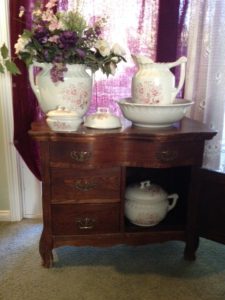 JH from Solvang has a Toilette set of glazed ceramic, and of course, she doesn’t use it to wash her face.
JH from Solvang has a Toilette set of glazed ceramic, and of course, she doesn’t use it to wash her face.
“I use the Water jug as a container for a big arrangement of artificial flowers in the living room,” she said. “The soap dish with lid I use as a candy dish.”
She placed the whole set upon a commode stand called a washstand, a special cabinet with a big cupboard to hold the bedpan/potty, covered and placed in the cupboard for the servants the next day.
The name toilet comes from the French ‘little cloth’ used upon rising in the morning, usually witnessed, if you were ‘high born’, by the court or ladies in waiting. By the time JH’s service was offered for sale, the middle class also bought such sets, usually a wedding present given to the wife. This gift contained a double meaning. The morning ablutions were private, and a new husband giving this set to his betrothed sent the message, “I hope to see you in bed soon!”
One notes with a smile that none other than Prince Albert was not beyond this suggestive gift. Queen Victoria’s Minton porcelain toilette service, given to her as a Christmas present by Prince Albert in 1853, is on display today in her former dressing room at Osbourne House.
The finest sets were made of precious gold or silver in the 18th century. A 1740 German service in the collection of the MET in NY consists of 47 pieces, including an inkstand for morning letters and a small snack plate and teapot for a nibble, as well as a tongue-scraper. If you were very noble, you took your toilette service with you in a custom-made case, and this could contain everything anyone could imagine in 1700 for the dressing table. When the gentry took these sets on a trip, they were called ‘necessaires.’ You think your dopp kit is BIG; these ‘necessaires’ could be the size of a large dresser, and take three men to load into the carriage.
JH’s middleclass American service has two ewers and one basin for washing. JH’s set hails from 1878-1890. Two ewers, one used for cold water, the other for hot water. Most middle class services had just one ewer and a smaller ‘slop’ basin for the used water, this slop basin had a lid. For the gents, there was a shaving mug with a lip upon which to rest the shaving brush. I’ve seen these misnamed as mustache tea or coffee cups!
JH’s set has a covered soap and sponge box, called the Mazarin, after the French Noble who pioneered this style. JH inherited this from her father so the original set might have included, along with a shaving mug, a toothbrush vase or box. These sets were current with the upper class until about 1850 then the middle class caught on that these sets bespoke class.
When I discuss these toilette services, folks think they’re decorative, meant for the side tables on Victorian hotels. No, they were necessary if you wanted to have water in your home for a morning wash, used before the days of indoor plumbing. Indoor plumbing didn’t arrive in rural America until 1930. Such noble edifices as the White House did not receive indoor plumbing until Millard Fillmore, who installed it between 1850-53. In 1940, nearly half of all homes in America lacked indoor hot-piped water, a bathtub or shower, or a flush toilet. The pull chain toilet wasn’t introduced to America until 1890 when only the wealthy and the finest hotels could afford such a luxury.
The problem of the valuation of such sets is that practically NONE are complete. One cover is usually missing, a vessel is cracked, or a pitcher is requisitioned. And JH’s is indeed not complete. People handled these sets every day, moved the pitcher from the outdoor pump or hot ring in the kitchen to the bedroom.
Upon the introduction of indoor plumbing, folks got rid of these sets, as they signaled you couldn’t afford indoor plumbing.
I’ve seen many a popcorn night at friend’s homes spoiled when I announce that the popcorn bowl originally served as a potty for their great-grandfather in 1870.
The value of JH’s set? $250-350. The bottom gives the pattern name “Dakota”, and since this set dates from before import export rules mandated country of origin stamps or even manufacture’s stamps, all we know is the pattern name.
I’ve heard that some people think that the covered chamber pots are soup tureens!
Pingback: Thunder Mug Not For Bathroom Use - Elizabeth Appraisals
Pingback: Mystery of a Loved Ewer - Elizabeth Appraisals